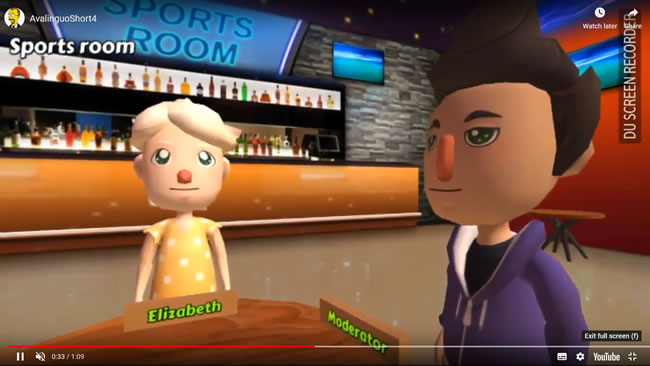
Here’s a recording in a mystery language.
Can you identify the language, and do you know where it’s spoken?

Here’s a recording in a mystery language.
Can you identify the language, and do you know where it’s spoken?
One of the words that came up this week in the French Conversation Group I’m part of was chaire [ʃɛʁ], which means chair (a professorship), pulpit, rostrum or throne.
Here are some examples of how it’s used:
Source: Reverso
Chaire comes from the Middle French chaire (chair (item of furniture)), from the Old French chaiere, chaere, from the Latin cathedra (armchair, ceremonial chair, the office or rank of teacher or bishop), from Ancient Greek καθέδρα (kathédra – seat; chair; rower’s seat; posterior, bottom; base of a column; sitting posture; teacher’s / professor’s chair; imperial throne), from κατά (katá – down) and ἕδρα (hédra – seat) [source].
The English words chair and chaise come from the same root, via the Old French chaiere, chaere [source].
Cathedral comes from the the Late Latin ecclesia cathedralis (church of a bishop’s seat), from the Latin cathedra [source].
Sit comes from the Old English sittan (to sit), from the Proto-Germanic *sitjaną (to sit), from the Proto-Indo-European *sed- (to sit), which is also the root of the Ancient Greek word ἕδρα (seat) [source].
Other words from the same root include:
Source: Wiktionary
Today we have a guest post by Ramon Brena of Avalinguo
When we see the acronym “VR”, we immediately think of headsets and gaming, as well as of fantasy dystopian worlds like in Spielberg’s Ready Player One, where everything, I mean everything, is done in VR.
Well, perhaps not everything in the real world, but could we learn to speak languages in VR? Now that travel is not possible because of COVID-19, could we engage in lively conversations with Parisians in a VR Montmartre pub?
Put like this, we have to answer “No”. To begin with, Paris is one of the worst places to practice French with the locals (as it was commented by Benny Lewis in the Language Hacking Podcast): if you want to speak French with the locals, you better go to a small town in France. Believe me on this, I lived for 6 years in France.
Then, a more basic question, Who are we going to talk to in VR? There are two broad answers to this question, and each of them takes a completely different approach to interaction in VR.
We call the first approach “simulation-based”. As you know, VR has been applied for educational purposes using the VR capabilities for simulating a world, could it be the bloodstream inside arteries in the body, or the working of complex mechanical contraptions, or… the situation inside a taxi in a foreign city.
The cab example was taken from the Mondly-VR app (headset plug-in for the Mondly app), which I bought for my Oculus. They use the synthetic worlds construction capabilities of VR to show you very compelling city views taken from inside the cab. The cab driver turns to you like expecting to have your instructions.
After that, things become a bit awkward. You have to interact with the driver using one of the options written for you on-screen and… Wait a moment, do you have to answer using predefined scripts? Here the magic starts to vanish. Dialogs are not natural, speech recognition leaves a lot to desire, and in general, the interaction doesn’t feel at all like a human conversation where only you know what you want to talk about.
To be fair, Mondly does a good job at the virtual scenario construction, but the interaction engagement wears off very quickly as the novelty fades out. Mondly-VR is available for several VR headsets and builds on top of its popular smartphone app. You can learn the language lessons on the smartphone alone, but of course, in the little cellphone screen, Mondly graphics look far less impressive than with the headset.
We call the second approach for language practice with VR “interaction-based” and it consists of putting in a virtual world the avatars of several humans. In this case, the language practice aspect is taken care of completely by those humans, who converse as they want. In this approach, the interaction is, of course, more natural just because it is done by humans, but then other less obvious problems arise.
There are several general VR platforms that can be used to have language practice conversations, like Mozilla Hubs (web browser-based), High Fidelity (audio only, I have used it for Meetup language gatherings), AltspaceVR (acquired by Microsoft some years ago), and others, which are not specifically intended to be used for language learning, but to some extent could.
I’m rather going to take as an example of this second approach the app Avalinguo, which is specifically intended for language learning (disclaimer: I’m the CEO of Avalinguo). I know, you are going to ask: In which headsets can I run Avalinguo? Right now in none. Avalinguo is a cellphone app.

The value of VR in Avalinguo is, first of all, to replace the face and body of the participants by avatars in order to give privacy. You know, talking is the most stressful language learning activity, and research studies have found that many self-conscious or shy people find it difficult to deal with. Some beginners feel judged or stupid when babbling in the language they are starting to learn. Linguists such as Luca Lampariello have proposed to change the attitude and embrace making mistakes, which is a good idea, but we propose to reduce the stress of the situation in the first place, by using avatars instead of showing your babbling face.
Another advantage of VR in Avalinguo (not yet currently released) is that role-playing games, which is one of the best language-learning practice activities, is greatly enhanced by the use of avatars already using a costume like a nurse, travel agent, bell boy, you name it. Other mini-game props such as roulette can be easily implemented, and there are hundreds of ready-to-use graphic resources to plugin.
Now, the distinction between the “simulation” approach and the “interaction” one is not clear cut, because, for instance, the use of costumed-avatars and props is a form of simulation. There is plenty of room for “simulation-interactive” hybrid approaches. The tricky aspect is to build it in such a way that it makes sense from an educational point of view, while at the same time making it entertaining and coherent.
So, in the end, the question is not if VR is ready for language-learning, but rather if language-learning is ready for VR, isn’t it?

Here’s a recording in a mystery language.
Can you identify the language, and do you know where it’s spoken?
If you like to make a fuss about things, to make a big deal out of things, or to make a song and dance about things, you could be said to be making a mountain out of a molehill.
This phrase first appeared in writing in 1548 in Nicholas Udall’s translation of The firſt tome or volume of the Paraphraſe of Eraſmus vpon the newe teſtamente as “The Lacos could abide no length, the Sophistes of grece coulde through their copiousnes make an Elephaunt of a lye, and a mountayne of a molle hill”. It is based on the Latin proverb “elephantem ex musca facere” (to make an elephant from a fly). It is possible that Udall coined the phrase, or that someone else did so around that time [source].
The word mole (as in the animal) comes from the Middle English mold(e)warp (“earth-thrower”). This became molle, and later mole. In Old English a mole was a wand, which became want, and a molehill was a wantitump.
In Dutch the equivalent of to make a mountain out of molehill is van een mug een olifant maken (“to make an elephant from a fly”).
Are there similar sayings in other languages?
Do you lollygag?
As a verb it means to dawdle, be lazy or idle, to avoid necessary work or effort. As a noun lollygag means silliness or nonsense [source].
I have been known to dawdle on occasion, and to loiter, tarry, dilly-dally, shilly-shally and even to procrastinate, but I rarely lollygag.
A nice equivalent of these words in Dutch is lanterfanten (to loiter, loaf/sit around, lollygag), which can be used in sentences like:
A lanterfanter is a slacker or good-for-nothing
and lanterfanteren means to waste one’s time or be lazy.
Lanterfanten comes from lanterfant (slacker, good-for-nothing, vagabond), from landtrouwandt (vagabond), from land (country) and trouwant (vagabond, beggar), from the Old French truant (vagabound, beggar, rogue) [source], which possibly comes from the Gaulish *trugan, or from the Breton truan (wretched) [source].
A related word is treuzelen (to dawdle, dilly-dally, stall).

Here’s a recording in a mystery language.
Can you identify the language, and do you know where it’s spoken?
There’s a rare word in Dutch – raar [raːr] – which is cognate with the English word rare, but means weird, strange, funny, odd or unusual.
It comes from the Middle Dutch rare (rare, unusual), from the Latin rārus (scattered, seldom, few, uncommon, thin, loose), from the Proto-Indo-European *h₁r̥h₁rós, from *h₁reh₁- (to separate) [source].
Here are some examples of how it’s used:
Source: Reverso Context
The Dutch words for rare include zeldzaam [ˈzɛlt.saːm] (rare, scarce), which is cognate with the Engish words seldom and seldsome (rare, uncommon), and schaars [sxaːrs] (scarce, rare, sparse), which is cognate with the Engish word scarce [source].
The English word rare comes from the same root, via the Middle English rare [ˈraːr(ə)/ˈrɛːr(ə)] (airy, vacuous, porous, breathable, sparsely spread, uncommon, scare, small, little), and the Old French rare/rere (rare, uncommon) [source].
Other descendants of the Latin word rārus include:
So rare, and its relatives, are strangely funny, wiredly unusual, outstandingly odd, loveably cute, nicely sweet, sparsely scarce and oddly rare words, it seems.
Now here’s a rare bird, a little bittern or Ixobrychus minutus:
The Dutch word saai [saːi] means boring, tedious or dull. It originally meant woven woollen cloth. By the 19th century it was being used to mean annoying, and also came to mean boring, because cloth was thought to be dull and uninteresting apparently [source].
Saai comes from the Middle Dutch saye / saey, from the Old French saie [sɛ] (a short garment worn by ancient Persians, Romans, and Gauls in combat), from the Latin sagum [ˈsa.ɡʊ̃ˑ/ˈsaː.ɡum] (a military cloak), from the Ancient Greek σάγος [ˈsa.ɣos] (cloak, coat, habit), [source] from the Gaulish *sagos [source], from the Proto-Celtic word *sago- (a coarse woollen blanket or mantle) [source] (PDF), from the Proto-Indo-European *sagom (mantle) [source]
The word sagum also exists in English, and refers to a cloak, worn in ancient times by the Gauls, early Germans, and Roman soldiers, made of a rectangular piece of (usually red) coarse cloth and fastened on the right shoulder (see the photo below).
Words that come from the Latin sagum include the Spanish saya [ˈsaʝa] (skirt, petticoat, dress, woman), the Portuguese saia [ˈsajɐ/ˈsaja] (skirt, woman), and the obsolete French word sayon [sɛ.jɔ̃] (cassock, jacket) [source].
Here’s a recording in a mystery language.
Can you identify the language, and do you know where it’s spoken?